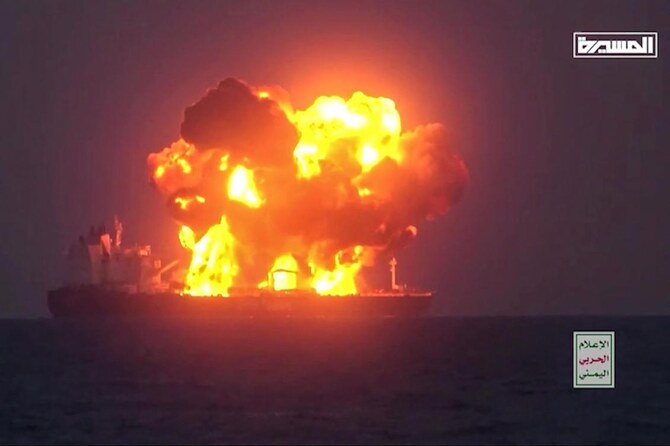DUBAI: Fires broke out Friday on a Greek-flagged oil tanker previously attacked by Yemen’s Houthi rebels this week, with the vessel now appearing to be adrift in the Red Sea, authorities said.
It wasn’t immediately clear what had happened to the oil tanker Sounion, which had been abandoned by its crew on Thursday and reportedly anchored in place.
The Houthis didn’t immediately acknowledge the fire. The rebels are suspected to have gone back and attacked at least one other vessel that later sank as part of their monthslong campaign against shipping in the Red Sea over the ongoing Israel-Hamas war in the Gaza Strip. The attacks have disrupted a trade route that typically sees $1 trillion in goods pass through it annually.
The British military’s United Kingdom Maritime Trade Operations center reported the fires in a note to mariners on Friday night.
“UKMTO have received a report that three fires have been observed on vessel,” the center said. “The vessel appears to be drifting.”
A United States defense official, speaking on condition of anonymity to discuss intelligence matters, said American officials were aware of the fires and continued to monitor the situation.
The vessel had been staffed by a crew of 25 Filipinos and Russians, as well as four private security personnel, who were taken by a French destroyer to nearby Djibouti, the European Union’s Aspides naval mission in the Red Sea said Thursday.
The Sounion has 150,000 tons of crude oil aboard and represents a “navigational and environmental hazard,” the mission warned. “It is essential that everyone in the area exercises caution and refrains from any actions that could lead to a deterioration of the current situation.”
Late Friday night, the Houthis released footage of an explosion striking the Sounion, their fighters on the water in the distance chanting the group’s slogan: “God is the greatest; death to America; death to Israel; curse the Jews; victory to Islam.”
A frame-by-frame analysis of the video conducted by The Associated Press suggested three simultaneous explosions struck the deck of the Sounion. That signature suggests an attack conducted by planted explosives, rather than a strike by missile or drone.
The Houthis have targeted more than 80 vessels with missiles and drones since the war in Gaza started in October. They seized one vessel and sank two in the campaign that also killed four sailors. One of the sunken vessels, the Tutor, went down after the Houthis planted explosives aboard it, after its crew abandoned the ship due to an earlier attack, the rebel group later acknowledged.
Other missiles and drones have either been intercepted by a US-led coalition in the Red Sea or failed to reach their targets.
The rebels maintain that they target ships linked to Israel, the US or the UK to force an end to Israel’s campaign against Hamas in Gaza. However, many of the ships attacked have little or no connection to the conflict, including some bound for Iran.
As Iran threatens to retaliate against Israel over the assassination of Hamas leader Ismail Haniyeh in Tehran, the US military told the USS Abraham Lincoln aircraft carrier strike group to sail more quickly to the area. Early Thursday, the US military’s Central Command said that the Lincoln had reached the waters of the Middle East, without elaborating.
Washington also has ordered the USS Georgia-guided missile submarine to the region, while the USS Theodore Roosevelt aircraft carrier strike group was in the Gulf of Oman.
Additional F-22 fighter jets have flown into the region and the USS Wasp, a large amphibious assault ship carrying F-35 fighter jets, is in the Mediterranean Sea.
Early Saturday, the US military’s Central Command said it had destroyed a Houthi missile system in Yemen over the last 24 hours.
























